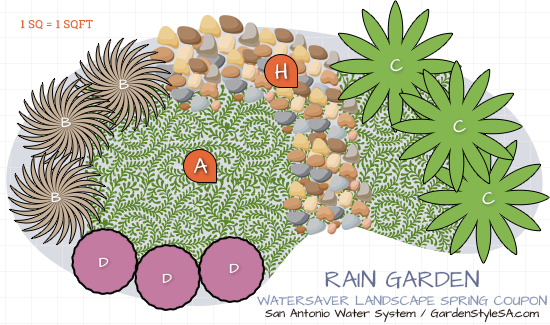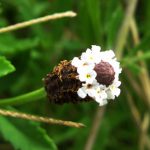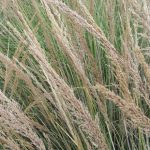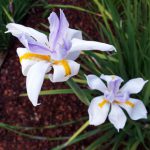In San Antonio, the main advantages of planting a rain garden are two-fold: it slows down the rain to prevent pollution and saves a ton of water in the process.
Check to see if we have a WaterSaver Landscape Coupon available to purchase the plants for your rain garden! Plus, 200 square feet is the perfect size for one.
Rain gardens are shallow, flat bottom bowl-shaped landscape beds, generally 6 to 9 inches deep with sloping sides to draw in rain flowing from your roof, sidewalks, and driveway. They basically prevent your run-off from flowing down the street, picking up pollutants and carrying them to creeks and waterways.
Be aware there is a lot of digging required for this project and location makes a difference in how beneficial your rain garden is for the environment.
Native plants are particularly suited to this type of habitat as they have evolved to cope on their own through long droughts punctuated with heavy rains.
- Choose a spot in your front or backyard, but the front may be best for intercepting rain before it hits the street. Make sure the area is at least 10 feet from your house and in full sun. Avoid utility lines and septic tanks.
- If your home has gutters and downspouts, you can redirect the spouts into the rain garden. As you layout your rain garden, think about where the rain will flow in and where it might overflow in case of a gully-washer. One way to alleviate overflow is to construct a dry creek bed through your rain garden to help diffuse the rain as it comes in.
- As you choose your plants here are a couple of things to remember. The plants on the floor of your rain garden bed should be low-growing and able to tolerate sitting in water for 24 to 48 hours, and still be able to take the summer heat without supplemental irrigation. Woody plants or ornamental grasses will work for the sides of the garden.
Rain gardens work best in the central and south parts of San Antonio. In areas with very thin soils, a cistern could be used to slowly release captured rainwater into a constructed dry creek bed with a slight berm.
Here is a sample rain garden bed using plants from our spring coupon. There are only 15 plants included (per coupon requirements), but you’re welcome to add more.

| Key | Dana’s Picks | Alternatives | |
|---|---|---|---|
 |
 |
Frogfruit | Purple Heart |
 |
 |
Muhly, Lindheimer’s | Turk’s Cap |
 |
 |
Iris, Butterfly | Shrimp Plant |
 |
 |
Mistflower, Gregg’s | Crinum Lily; Sage, Little-leaf |
 |
Hardscape | ||


